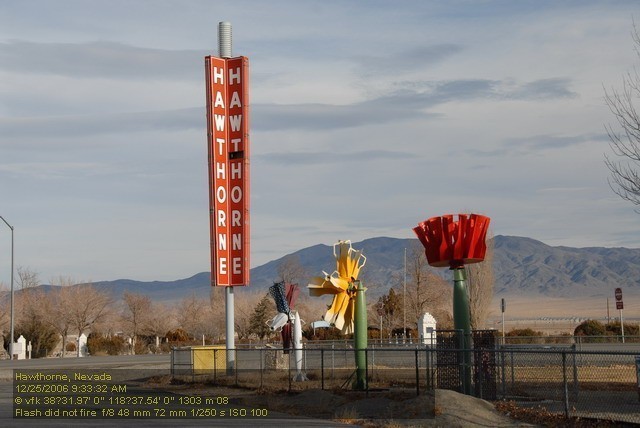In July of 2017, after much deliberation, my wife and I decided to move our household from South Orange County, California to mostly rural and rather remote Hawthorne, Nevada. The cost of living in Orange County was skyrocketing. My employer, nine months after handing me a nice raise and promotion, decided to backpedal that raise by changing my pay grade (essentially a 10% cut in pay), ultimately maxing me out with no chance of a future raise (not even an annual merit increase). My wife telecommutes, so she can work virtually anywhere as long as she can get decent internet. Two years earlier, my mother in law had passed away and left us two properties in Hawthorne. With my cut in pay becoming effective in August 2017, and my wife travelling back and forth trying to close the estate, we made the move.
In Orange County, our internet provider was Cox Communications, and they were actually pretty good. We were paying about $160 per month for TV, phone, and internet (150 Mbps down, 30 Mbps up), with no pay channels like HBO. This was pretty much the norm in this very metropolitan suburban area of Los Angeles.

Hawthorne, Nevada is a small military town, home of the Hawthorne Army Depot, the largest weapons decommission site in the world. The town has a population of roughly 3,226 (per a 2010 census), has an elevation of 4,331 feet, is the county seat for Mineral County, and is located 125 miles south of Reno and 314 miles north of Las Vegas. The major retailer is Safeway, and the town has very few restaurants – the largest being the smoke-filled coffee shop inside the El Capitan casino, the rest are mostly fast-food oriented such as McDonalds and Mr. Beane’s Coffee Stop, or bars. Nearest towns are Luning (population 87) 25 miles southeast, Mina (population 155) 34 miles southeast, Walker Lake (population 275) 13 miles north, Schurz (population 658) 34 miles north, and Bishop, California (population 3,782) 120 miles south. Hawthorne has no movie theater (it closed several years ago), and the median income is just over $34,000. The closest Wal-Mart is in Fallon, NV (73 miles north) and the closest Best Buy is in Sparks, NV (120 miles north).

Up until a year ago, internet options in Hawthorne were pretty scarce. My mother in law many years prior had AT&T DSL service, offering 1.5 Mbps down and 500kbps up, which at the time and for what she was using it for was acceptable. During one of her trips to Reno, she stopped in to the Verizon store to replace her phone, and the sales rep talked her into switching to a Verizon JetPack for her internet needs. To this day, it still leaves a bad taste in my mouth, as I feel that the salesperson took advantage of an elderly lady who was not all that tech savvy. Because she used a flip phone and really only used the internet for e-mail and occasional web surfing, she rarely exceeded her 2 Gb data plan. When my wife moved in after her passing, this was her main source for internet for almost a year, playing the data plan game by constantly gauging her usage and calling quite literally at the last minute to increase the data plan if it looked like she was going to go over for that month, then downgrade it back to the 2 GB plan once the new billing cycle kicked in. Speeds were decent, usually 40 Mbps down and 15 Mbps up, but pings were often all over the place (sometimes as high as 125ms). The cost was $45 per month, not including the line for my wife’s smart phone, and the data plan was shared with both devices. Growing tired of playing the data plan game and the latency issues, not to mention the short battery life on the JetPack, it was time to look for an alternative.
A quick search in 2016 found only a handful of providers: Verizon Wireless, Choice Wireless, and AT&T. Charter Communications, the local cable TV provider, was only offering TV service at the time. Choice was a local company, but also the most expensive and slowest: from $29.99 per month for 2Mbps down and 1 Mbps up to $79.99 per month for 9 Mbps down and 2 Mbps up, supposedly with unlimited data. AT&T was a bit better: $45 per month for 18 Mbps down and 1.5 Mbps up limited to 1 TB per month. A friend from church recommended AT&T, as he had been using them for years at both his home and small business. And for the next two years, AT&T seemed to work just fine for my wife, as she was only using it for her laptop during business hours and her smart phone whenever she was in the house. When I arrived a year later with two home theater setups (which included several streaming devices) and two computers, the router built in to AT&T’s modem (which has some of the worst reviews of a telecommunications device I’ve ever read) couldn’t handle the traffic and would randomly shut down during business hours. The problem was eventually resolved when we overrode the built-in router and used an eero router to handle our wireless internet traffic. For almost a year, on average, we really didn’t have too many issues, as long as I limited my internet usage during the day (no video streaming, limit software and firmware updates to the weekend or evenings). We were even able to watch Netflix and Amazon Prime Video in 4K, as long as neither of us were streaming or downloading on our other devices. Plus, when we added DirecTV to our AT&T plan, the 1 TB data cap became unlimited (likely because DirecTV requires an internet connection for on-demand programming).
Six months ago, however, our experience with AT&T began to deteriorate. We would get random outages, usually during the middle of the day, for about 30 minutes at a time. Calling tech support was useless, as they would just schedule a service call. Living in a small town, we had one of the local AT&T technician’s cell phone number, and would then call him to see if he or one of his co-workers was performing maintenance in town. His usual response was that there wasn’t any maintenance at the local station, but it was likely that someone at another substation was performing undocumented maintenance, because he was seeing the same errors we were seeing, such as major drops in speed and other latency issues. I began researching, and found that Charter Communications, now known as Spectrum, was finally offering internet and phone service here in Hawthorne (they began about a year prior). In fact, they had just upgraded their systems to Docsis 3.1 and began offering gigabit internet (technically 960 Mbps) in this tiny remote town. The cost for gigabit internet was a bit out of reach ($125/month), but Charter was offering new customers a free upgrade to their 400 Mbps service for the price of their 100 Mbps service for three years, with a two-year price lock for $44.99, plus $49.99 install. My response – “Where do I sign?” Service has been very good, with fairly steady speeds for the most part, and sudden dips have been rectified fairly quickly by fairly knowledgeable technicians.
Here is where things get rather interesting. Charter is actually leasing AT&T’s internet fiber line coming into town, and according to two of Charter’s technicians, they are constantly installing TV and internet services to new customers who are dropping their AT&T and/or satellite services. I have spoken to one of the local AT&T technicians, who on the condition of anonymity, mentioned that he is basically waiting for the other foot to drop, since AT&T has no plans whatsoever to upgrade the wiring in town to even try to compete with Charter. To AT&T’s benefit, though, Charter does not offer any kind of services to the outlying communities of Walker Lake, Luning, or Mina. Those communities are limited to Choice Wireless, AT&T DSL, or Verizon Wireless. The fact that these smaller towns do not have access to what many take for granted – true high-speed internet, should not be all that surprising. Articles published by the Pew Research Center in October 2018 reported that 15% of all US households with children ages 6 to 17 do not have a high speed internet connection (it jumps to 35% for households with an annual income of less than $30k), and in September of that same year it was reported that 24% of adults living in a rural community find it difficult to get high speed internet at home. According to a report by Microsoft that was published in December 2018, more than 19 million people living in rural America do not have access to broadband internet (25Mbps down/3Mbps up). The citizens of Hawthorne, Nevada can probably thank the US Army and the contractor currently running operations at the base for the fiber pipeline coming into town, as they are necessary for their day to day operations. There is a glimmer of hope, though, for some of this nation’s rural communities. In Microsoft’s December 2018 report, they also pledged to bring broadband to rural communities, hoping to serve 3 million people who are unable to connect at high speeds by July 2022.
Todd Erwin has been a reviewer at Home Theater Forum since 2008. His love of movies began as a young child, first showing Super 8 movies in his backyard during the summer to friends and neighbors at age 10. He also received his first movie camera that year, a hand-crank Wollensak 8mm with three fixed lenses. In 1980, he graduated to "talkies" with his award-winning short The Ape-Man, followed by the cult favorite The Adventures of Terrific Man two years later. Other films include Myth or Fact: The Talbert Terror and Warren's Revenge (which is currently being restored). In addition to movie reviews, Todd has written many articles for Home Theater Forum centering mostly on streaming as well as an occasional hardware review, is the host of his own video podcast Streaming News & Views on YouTube and is a frequent guest on the Home Theater United podcast.
Post Disclaimer
Some of our content may contain marketing links, which means we will receive a commission for purchases made via those links. In our editorial content, these affiliate links appear automatically, and our editorial teams are not influenced by our affiliate partnerships. We work with several providers (currently Skimlinks and Amazon) to manage our affiliate relationships. You can find out more about their services by visiting their sites.





Similar threads
- Carl David
- Movies
2 3